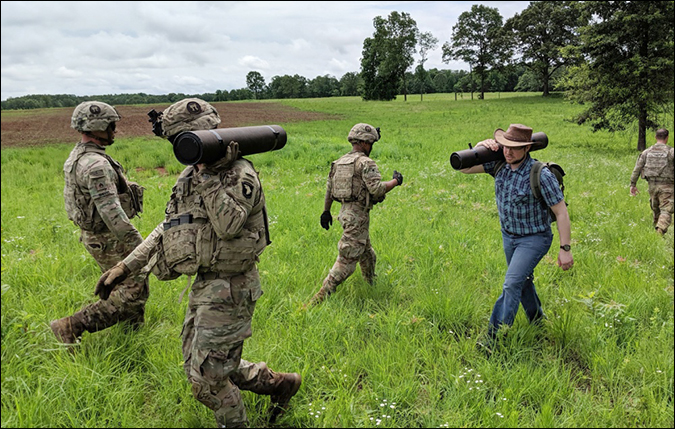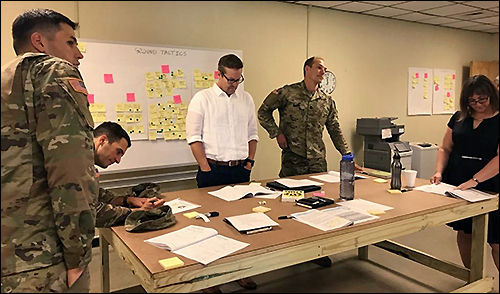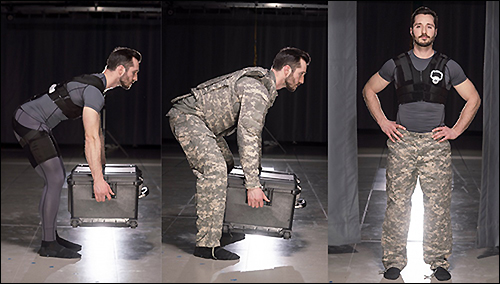
GPS, duct tape, microwaves and computers—these everyday items have one thing in common: Each invented, in part or in whole, as the result of U.S. military research.
The military’s rich history of innovation continues today at numerous labs and engineering centers. There is a gap, however. There are myriad problems at the warfighter level that Army labs never encounter. Soldiers from the 3rd Brigade Combat Team of the 101st Airborne Division at Fort Campbell, Kentucky, and researchers at Vanderbilt University’s School of Engineering are addressing this gap and building a partnership to identify and solve tactical problems with soldier-inspired solutions.
The relationship between 3rd BCT and Vanderbilt began in early 2018 with a simple question: Can we 3D-print tools to make jobs easier? Andrew Shaughnessy, 1st Lt. and a howitzer platoon leader in 3rd BCT, knew some of the wrenches his platoon uses on the guns are unwieldy and expensive. He knew additive manufacturing—or 3D printing—could supply those wrenches inexpensively and quickly—right where they’re needed.
Shaughnessy needed a design partner because he lacked the technical knowledge to design and print the wrench he had in mind. He reached out to Kevin Galloway, associate professor of mechanical engineering and Director of Making, to see if he was interested in collaborating. Located just a short hour’s drive away from the 3rd BCT’s home base in Kentucky, Galloway’s lab had both the equipment and personnel to help. Galloway oversees Vanderbilt’s Wond’ry Makerspace, a lab outfitted with fabrication and manufacturing equipment for rapid prototyping.
Galloway and Shaughnessy designed and produced a few wrenches and the innovation partnership was underway. This relationship exists in large part because Col. John Cogbill, commander of 3rd BCT, has written at length about building a culture of innovation. With innovation as one of his command priorities, he has worked to enable soldiers to become problem-solvers, free to identify opportunities for change and test their ideas in tactical settings.

Even before 3rd BCT began working with Vanderbilt, the brigade hosted a number of innovation forums, including Shark Tank-style open-mic nights for soldiers to bring ideas to a panel of leaders from within the organization. Including Vanderbilt in the innovation process has led to a robust relationship, which now includes regular visits between Fort Campbell and the Vanderbilt campus as well as substantial growth in the number of collaborative projects.
Although the initial scope of the collaboration was small, 3rd BCT soldiers quickly realized they had a winning formula on their hands. On April 9, 2019, the Army Futures Command and the university signed a five-year education partnership agreement that links creative, innovative soldiers with top-tier Vanderbilt experts so that ideas quickly can become useful products. Education partnership agreements have been signed in the past, but this was the first time a brigade was specifically included as an official partner to such a pact.
What began with 3D-printed howitzer firing-pin wrenches now includes 12 (and counting) soldier-inspired and soldier-informed projects, including:
Improving fighting positions. When soldiers dig hasty fighting positions, they do so with small, collapsible entrenching tools that are difficult and time-consuming to use. A design class taught by Galloway is tackling the issue with ideas like rapidly deployable fillable barriers and redesigned shovels. They are partnered with the 3rd Battalion, 320th Field Artillery Regiment in the 3rd BCT.

Lift-assisting exosuits. Karl Zelik, assistant professor of mechanical engineering, biomedical engineering and physical medicine and rehabilitation at Vanderbilt, discovered that more than 1,000 soldiers are diagnosed with back injuries every day. He and his team are working on biomechanically assistive garments that can reduce load on soldiers’ bodies and improve their effectiveness.
Helmets, traumatic brain injury and soldier performance. Doug Adams, Daniel F. Flowers Professor and chair of the Civil and Environmental Engineering Department, and Tonia Rex, associate professor of ophthalmology and a researcher in the Vanderbilt Eye Institute, visited training events held by the 3rd Battalion, 187th Infantry Regiment in the 3rd BCT. Their initial project focused on incorporating sensors into helmets to gauge their effectiveness and protect against TBI, and assessing and predicting TBI in soldiers. Discussion with the unit, however, led to a new idea of exploring cognitive markers for improving soldier performance in stressful situations, leveraging assets like the Electronic Skills Trainer within the 101st.
Material results are only one of the benefits provided by the relationship. On June 20, Vanderbilt faculty and commanders and staff from across the 101st participated in an innovation workshop hosted in the newly designated EAGLEWERX Innovation Lab at Fort Campbell. About 30 attendees undertook a crash course in the innovative design process, which is a structured approach to product development that includes problem identification, idea generation and prototyping.
In just four hours, the group devised a broad range of technologies, processes and organizational changes tailored toward improving air assault operations. Following the success of this “design sprint,” the 101st and Vanderbilt will conduct similar events at multiple echelons, including quarterly innovation symposiums at the division level.
Future opportunities for collaboration includes a recurring series of classes to teach soldiers to use 3D printers, laser cutters, mills and other manufacturing equipment to bring their ideas from sketch to minimum viable products—one with just enough features to satisfy early users and allow them to provide feedback that will inform future iterations.
Another development is the establishment of permanent innovation positions within the division with liaisons from AFC to the 101st, and from the 101st to Vanderbilt. Conferences, experimentation, joint training events and fellowships are all additional possibilities.
Soldiers today operate on a fast-paced and dynamic battlefield. This partnership prepares them for uncertainty by enabling them to identify and solve problems as they encounter them, often in the absence of orders, improve methods the Army has traditionally used, and create an entirely new status quo.
+++
By 1st Lt. Austin Herrling
This article was published by the Defense Visual Information Distribution Service and will be published in the 2019 Fall issue of Army AL&T magazine. Herrling is the chief innovation officer and knowledge management officer for 3rd BCT. He holds a Master’s degree in operations research from the Massachusetts Institute of Technology and a bachelor’s degree in mathematics and computer science from the United States Military Academy at West Point.